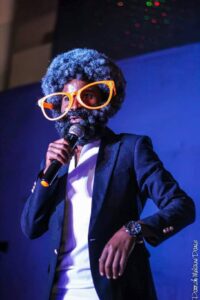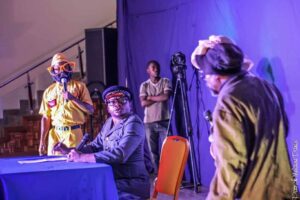
Impact Story 10: Theater drives change for people and nature in Virunga
By IUCN
Virunga National Park in the Democratic Republic of Congo is home to many (endangered) species, such as mountain gorillas, elephants, and hippos. The area’s inhabitants often depend on this biodiversity for their livelihoods, but people and wildlife also conflict from time to time. Armed groups, illegal activities, and population growth put more pressure on the national park. IUCN NL aims to reconnect young people with nature. But how do cultural activities create ‘Actors of Hope’?
Congolese youngsters are the driving force for change
Through its project partners FESCO, FECOPEILE, IDPE, and FMMC in the DRC, IUCN NL works with Congolese youngsters so they can stimulate change. Chalondawa Mushiwa Jonathan, a well-known artist from Goma and part of Foundation Mzee Mbukuli Comedy (FMMC), plays a key role in this project by organising cultural activities. He explains how these activities improve the relationship between people and nature. We have spoken him about nature and his role.
Mushiwa Jonathan, a well-known artist from Goma and part of Foundation Mzee Mbukuli Comedy (FMMC), plays a key role in this project by organising cultural activities. He explains how these activities improve the relationship between people and nature. We have spoken him about nature and his role.
What are the challenges for nature conservation in Virunga?
‘Poaching and deforestation threaten the conservation of Virunga, and land issues create conflicts between the people living in the area and the park authorities. Imposters sell land that actually belongs to the park, after which houses need to be demolished. This creates tensions that sometimes lead to lawsuits.’
How does theatre stimulate positive change?
‘We organise theatre productions with the people from the villages. Working closely together dramatically increases awareness of nature conservation, especially because we perform real-life situations on stage. It stimulates change at another level. These theatre shows are made with love and joy.
We also produce short films with young people to inspire them and others to conserve the national park. In these video productions, we show land conflicts and other situations they may experience in their life. To reach as many people as possible, the actors, cast in the villages, speak Swahili. We publish the films on social media, broadcast on local television, and organise public screenings for youth.’

What changes do you see?
‘By acting in real-life situations, we share alternative solutions to land conflicts and other problems. We show why deforestation and other forms of disrupting nature are not solutions in the long term. Some videos inform the audience about possible imposters and share the park’s legal context. Most of all, the productions encourage people to contribute to nature in a positive way, even though their personal, cultural and societal situation challenges that from time to time.
In addition to driving change for nature conservation, the videos and theatre shows often function as social therapy: it is a positive alternative to deal with their problems together as a community. Sometimes, it also helps them stay away from problems because they know how to identify imposters and other people who may put them in complicated situations.
I have noticed that youth organise their own theatre groups inspired by our work. Creatively working on these topics helps them better understand the choices they have in their lives. Most of them learned that rangers are not the enemies, but young people like them trying to protect a pride of the world: Virunga National Park.’
Working on these topics in a creative way helps young people to better understand the choices they have in their lives. Most of them learned that rangers are not the enemies, but young people like them trying to protect a pride of the world: Virunga National Park.’
Virunga Youth: Actors of Hope
The project Virunga Youth: Actors of Hope stimulates Congolese youngsters to become actors of change for a better future for the Virunga area. Through its local partner organisations FESCO, FECOPEILE, IDPE, and FMMC, IUCN NL aims to get young people acquainted with the importance of Virunga National Park and get their support in the national park’s conservation efforts.